

The Decorated Apparel and Promotional Products Resource. The Decorated Apparel and Promotional Products Resource.
Embroidery Software Protection Coalition. The Embroidery Software Protection Coalition (ESPC) is a United States embroidery industry trade group.
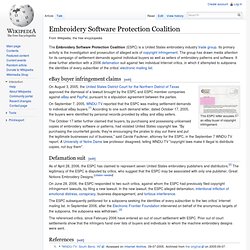
Its primary activity is the investigation and prosecution of alleged acts of copyright infringement. The group has drawn media attention for its campaign of settlement demands against individual buyers as well as sellers of embroidery patterns and software. It drew further attention with a 2006 defamation suit against two individual Internet critics, in which it attempted to subpoena the identities of every subscriber of the critics' electronic mailing list. eBay buyer infringement claims[edit] This ESPC letter accuses an eBay buyer of copyright infringement.
On August 3, 2005, the United States District Court for the Northern District of Texas approved the dismissal of a lawsuit brought by the ESPC and ESPC member companies against eBay and PayPal, pursuant to a stipulation agreement between the parties. Free Embroidery Lessons - Embroidery Stitches. How to Learn Embroidery Stitches. Head of tiger (silk embroidery)
Smocking. Smocking on the collar of a sixteenth-century garment.
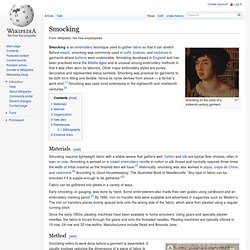
Smocking is an embroidery technique used to gather fabric so that it can stretch. Before elastic, smocking was commonly used in cuffs, bodices, and necklines in garments where buttons were undesirable. Smocking developed in England and has been practised since the Middle Ages and is unusual among embroidery methods in that it was often worn by laborers. Other major embroidery styles are purely decorative and represented status symbols. Smocking was practical for garments to be both form fitting and flexible, hence its name derives from smock — a farmer's work shirt.[1] Smocking was used most extensively in the eighteenth and nineteenth centuries.[2]
PACK BORDADOS Wilcom 9 + Pe Design 6 + 100000 diseños+REGALO - 3595386 - disponible en SANTA FE. Software de digitalizacion es totalmente compatible con todas las maquinas que utilicen tarjetas BROTHER SA-309 y formato PES.

Bordadoras BROTHER SERIES PE - SERIES PC - SERIES ULT y otras maquinas de bordar de otras marcas que utilizan este tipo de tarjetas. Transfiera los diseños en cuestión de segundos a un pendrive, tarjeta de memoria o diskette. Learn Embroidery: Running Stitch: With a skein of floss, a needle, cotton fabric and a hoop you can learn a craft that is sew easy! One stitch at a time.
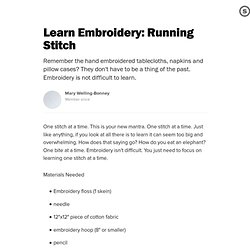
This is your new mantra. One stitch at a time. Just like anything, if you look at all there is to learn it can seem too big and overwhelming. How does that saying go? Embroidery stitch. An illustration of the buttonhole stitch.

In everyday language, a stitch in the context of embroidery or hand-sewing is defined as the movement of the embroidery needle from the backside of the fabric to the front side and back to the back side. The thread stroke on the front side produced by this is also called stitch. In the context of embroidery, an embroidery stitch means one or more stitches that are always executed in the same way, forming a figure of recognisable look. Embroidery stitches are also called stitches for short. Brazilian embroidery. The difference is caused by the method used to manufacture the rayon thread.
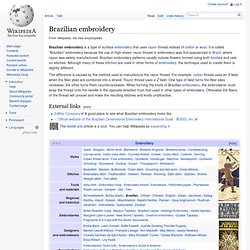
For example, cotton thread uses an S twist when the fiber plies are combined into a strand. Rayon thread uses a Z twist. One type of twist turns the fiber plies clockwise; the other turns them counterclockwise. When forming the knots of Brazilian embroidery, the embroiderer must wrap the thread onto the needle in the opposite direction from that used in other types of embroidery. Machine embroidery. Machine embroidery is an embroidery process whereby a sewing machine or embroidery machine is used to create patterns on textiles.

It is used commercially in product branding, corporate advertising, and uniform adornment. Hobbyists also machine embroider for personal sewing and craft projects. There are multiple types of machine embroidery. These include free-motion sewing machine embroidery, this uses a basic zigzag sewing machine. Ponchados Mexico - Servicio de Ponchado de Logos Computarizado para Bordado Express. Canvas work. History[edit] Early canvas work or needlepoint used tent, continental or basketweave stitches, with each stitch covering one canvas intersection.

Bargello, first developed in Europe, uses colors and stitches across multiple canvas intersections to create motion and patterns. Modern methods have incorporated crewel and other embroidery stitches to add depth and differences not only by shading but by texture. Contemporary materials[edit] Several types of embroidery canvas are available: single thread and double thread embroidery canvas are open even-weave meshes, with large spaces or holes to allow heavy threads to pass through without fraying. Canvas is measured by the number of squares per inch or centimetre. In canvas work the stitches may completely cover the canvas. Yarns vary from knitting yarns and tapestry wools to pure silk, synthetic, or metallic threads. Sweatshirt. Chain stitch. Traditional embroidery in chain stitch on a Kazakh rug, contemporary.
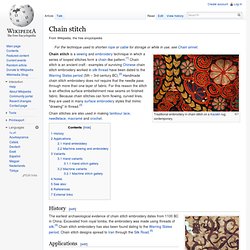
Chain stitch is a sewing and embroidery technique in which a series of looped stitches form a chain-like pattern.[1] Chain stitch is an ancient craft - examples of surviving Chinese chain stitch embroidery worked in silk thread have been dated to the Warring States period (5th – 3rd century BC).[2] Handmade chain stitch embroidery does not require that the needle pass through more than one layer of fabric. For this reason the stitch is an effective surface embellishment near seams on finished fabric. Because chain stitches can form flowing, curved lines, they are used in many surface embroidery styles that mimic "drawing" in thread.[3] Chain stitches are also used in making tambour lace, needlelace, macramé and crochet.
: Textília.net. Learn embroidery. AquaLOVE... DRAWstitch Technology and DRAWings embroidery software. Machine Embroidery Software Instruction At Erica's Craft & Sewing Center. Cross stitches. Detail of cross stitch embroidery from Sweden.

Cross stitch sampler with alphabets, crowns, and coronets, 1760 Cross stitch in canvas work Cross stitches in embroidery, needlepoint, and other forms of needlework include a number of related stitches in which the thread is sewn in an x or + shape. Cross stitch has been called "probably the most widely used stitch of all"[1] and is part of the needlework traditions of the Balkans, Middle East, Afghanistan, Colonial America and Victorian England. Applications[edit] Cross stitches were typical of 16th century canvas work, falling out of fashion in favor of tent stitch toward the end of the century.[2] Canvas work in cross stitch became popular again in the mid-19th century with the Berlin wool work craze.
Herringbone, fishbone, Van Dyke, and related crossed stitches are used in crewel embroidery, especially to add texture to stems, leaves, and similar objects. Embroidery. Diseno de ponchados para todas en MercadoLibre México - Donde comprar y vender de todo. Butterfly Embroidery Machines and Equipment - Since 1919. Couching. Detail of the Bayeux Tapestry showing fillings in laid work. In embroidery, couching and laid work are techniques in which yarn or other materials are laid across the surface of the ground fabric and fastened in place with small stitches of the same or a different yarn.[1] The couching threads may be either the same color as the laid threads or a contrasting color. When couching threads contrast with laid threads, patterns may be worked in the couching stitches.[2] Applications[edit] Laid work is one of two techniques used in the Bayeux Tapestry, an embroidered cloth probably dating to the later 1070s.
There is a strong tradition of couching stitch in Palestine. Couching stitch from Beit Jalla. 2006. Variants[edit] Stitch gallery[edit] Underside couching, front (left) and back (right) External links[edit] Notes[edit] The Amazing Bead Embroidery Technique! – What exactly is bead embroidery? This is an ancient hand embroidery technique which originated in Germany in the 12th century. The pattern was first drawn onto the parchment and then attached to the fabric.
The beads were strung onto one single thread, laid on the design in the desired manner and then couched into place with a thread and second needle. So there was a juxtaposition between the beads and the embroidery and this unique technque came to be known as bead embroidery. In today’s scenario, one generally takes 5 – 6 beeds on the needle at a time. Hastings Embroidery. The Hastings Embroidery was commissioned by Group Captain Ralph Ward and made by the Royal School of Needlework in 1965 to celebrate the 900th anniversary of the Battle of Hastings the following year.[1] Intended to be a modern day equivalent of the Bayeux Tapestry, the embroidery consists of 27 panels, each 9 × 3 ft, and shows 81 great events in British history during the 900 years from 1066 to 1966. It took 22 embroiderers 10 months to finish. The Embroidery was on public display in Hastings, firstly in the Town Hall and then on the pier in a domed shaped building. The Hastings Embroidery is currently in storage, and apart from two panels on permanent display in the Town Hall, can not be viewed, despite local campaigns to protest.
Broidery.Ru. Stitch School. A couple of weeks ago, Susan showed some very cool embroidered pictures of cottages on her T-Cozy blog. Knowing that I sell copies of vintage patterns on my website, she emailed to ask if I knew anyone who could take her original picture and make a pattern from it. It was a challenging picture to trace (lots of tiny leaves and flowers) but I told her I'd do it. Yes, it's possible to digitally trace original embroidery but it's not magic—you still have to do all the tracing.
It's just done with a mouse instead of a writing instrument and a steady hand and graphic design background doesn't hurt either. Starbird Incorporated -Embroidery Digitizing- Question about digitizing - DigitSmith. Candlewicking. This early American candlewick spread was made for a four-post bed, and includes fanciful botanical motifs, birds, and a central motif with an American eagle. Collection of Bill Volckening. Candlewicking, or Candlewick is a form of whitework embroidery that traditionally uses an unbleached cotton thread on a piece of unbleached muslin. It gets its name from the nature of the soft spun cotton thread, which was braided then used to form the wick for candles.
Needlepoint. Needlepoint cushion. Victoria's Secret: Lingerie and Women's Clothing, Accessories & more. Wilcom 9 SP4. Editing Wizardry. Learning embroidery digitizing - DigitSmith. Featherstitch. Mehndi. Stumpwork.